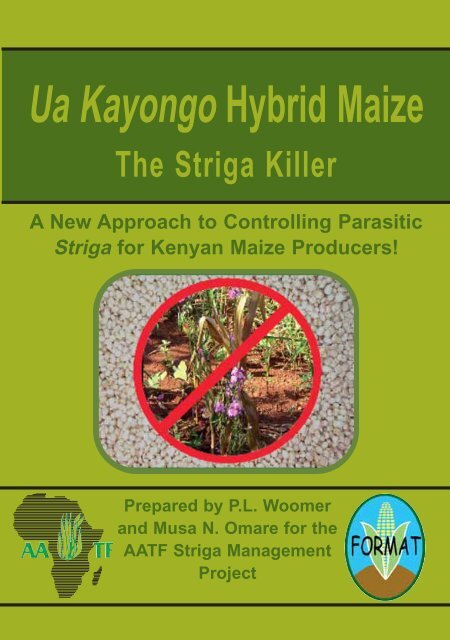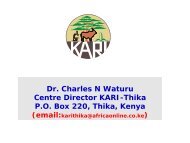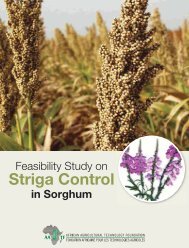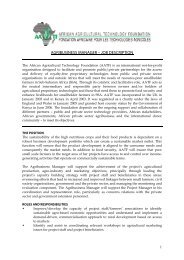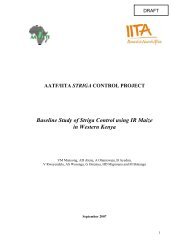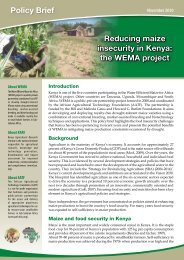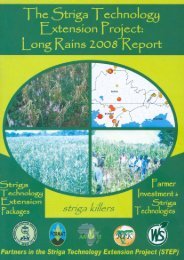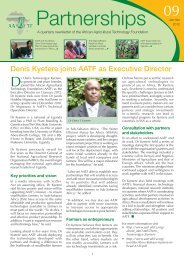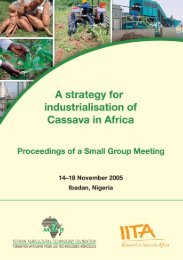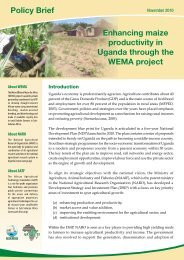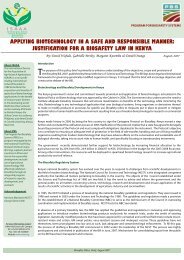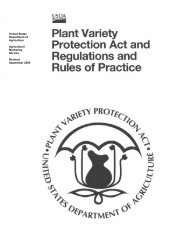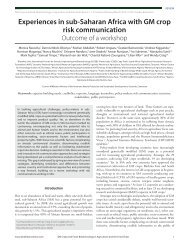Ua kayongo Maize - African Agricultural Technology Foundation
Ua kayongo Maize - African Agricultural Technology Foundation
Ua kayongo Maize - African Agricultural Technology Foundation
Create successful ePaper yourself
Turn your PDF publications into a flip-book with our unique Google optimized e-Paper software.
<strong>Ua</strong> Kayongo Hybrid <strong>Maize</strong><br />
The Striga Killer<br />
A New Approach to Controlling Parasitic<br />
Striga for Kenyan <strong>Maize</strong> Producers!<br />
Prepared by P.L. Woomer<br />
and Musa N. Omare for the<br />
AATF Striga Management<br />
Project
The Striga Killer<br />
<strong>Ua</strong> Kayongo Hybrid <strong>Maize</strong>: The Striga Killer<br />
A new approach to controlling parasitic Striga for Kenyan<br />
maize producers<br />
_____________________________________________<br />
Table of Contents<br />
Mobilizing Kenyan Farmers ……….……………….. 2<br />
Striga Threatens Farmers in Kenya …………...…... 3<br />
Know Your Enemy! ………………...………………... 4<br />
The First Line of Defense …………...…………….... 5<br />
Conventional Striga Management ………...……….. 6<br />
Introducing <strong>Ua</strong> Kayongo: The Striga Killer …...…… 7<br />
Five Easy Steps to Establish <strong>Ua</strong> Kayongo ……….. 8<br />
Other Benefits from Planting <strong>Ua</strong> Kayongo ….......... 10<br />
Questions and Answers on <strong>Ua</strong> Kayongo ……..…… 11<br />
Translated Summary: Kiswahili ………...………….. 13<br />
Translated Summary: Luo ………....………………. 14<br />
Translated Summary: Luhya ………..….………….. 15<br />
Credits and Contact Details ……..………………….. 16<br />
Prepared by P.L. Woomer and M.N. Omare for the <strong>African</strong><br />
<strong>Agricultural</strong> <strong>Technology</strong> <strong>Foundation</strong>’s Striga Management<br />
Project, Nairobi, Kenya, May 2005.<br />
Any portion or this entire booklet may be reproduced without<br />
permission so long as the copies are not used for commercial<br />
purposes and the authors and AATF are acknowledged.<br />
1
<strong>Ua</strong> Kayongo Hybrid <strong>Maize</strong><br />
2<br />
Mobilizing Kenyan Farmers Against Striga!<br />
Striga, popularly known as Kayongo (Luo) or Oluyongo<br />
(Luhya), is a parasitic weed that destroys cereal crops,<br />
particularly maize, leading to food insecurity in thousands<br />
of households. Striga feeds upon the sugars, mineral<br />
nutrients and moisture of its host and may result in<br />
complete crop loss under the worst of conditions. One<br />
plant produces numerous small seeds that are<br />
incorporated into the soil during tillage and remain<br />
dormant for many years. These seeds are also spread by<br />
dirty shoes and digging tools or by livestock and soil<br />
erosion. Striga should be hand-weeded and, together<br />
with affected crop residues, burned and buried to control<br />
its spread.<br />
A new maize hybrid, <strong>Ua</strong> Kayongo that is coated<br />
with Strigaway TM herbicide will soon be introduced in<br />
western Kenya to control Striga infestation in maize. The<br />
herbicide kills germinating Striga as it attempts to<br />
parasitize maize. <strong>Ua</strong> Kayongo is planted and managed<br />
much in the same way as other maize varieties by using<br />
recommended tillage, spacing, fertilizer and regular<br />
weeding. <strong>Ua</strong> Kayongo, however, cannot be planted in the<br />
same hole as intercropped legumes and farmers should<br />
thoroughly wash their hands after handling it, to avoid<br />
contaminating other seeds with the Strigaway TM<br />
herbicide.<br />
Farmers in western Kenya will soon have access<br />
to this new technology and are encouraged to combine<br />
<strong>Ua</strong> Kayongo with other Striga management technologies.<br />
The <strong>Ua</strong> Kayongo seeds will become commercially<br />
available to Kenyan farmers through Kenya Seed,<br />
Lagrotech Seeds and Western Seed companies prior to<br />
2005-2006 short rains through existing retail outlets.
The Striga Killer<br />
Striga Threatens Farmers in Kenya<br />
To fight the threat of Striga, farmers in Kenya now have a<br />
new maize hybrid <strong>Ua</strong> Kayongo that is coated with<br />
Strigaway TM herbicide that protects against and kills<br />
Striga. Another species of Striga attacks cowpea and<br />
other legumes in coastal Kenya, but this different<br />
parasitic weed is not covered in this booklet.<br />
For many years now, Kenyan farmers in Nyanza<br />
and Western Provinces have suffered from the parasitic<br />
weed commonly known as Striga or Kayongo as it<br />
destroys their cereal crops, particularly maize. Striga<br />
hermonthica has invaded approximately 200,000<br />
hectares of Kenyan cropland resulting in losses of about<br />
KSh 800 million each year and this weed is continuing to<br />
spread! Striga is a major contributor of food insecurity<br />
among thousands of households in west Kenya as it<br />
causes yield losses of maize, the major food crop.<br />
3
<strong>Ua</strong> Kayongo Hybrid <strong>Maize</strong><br />
Know Your Enemy!<br />
Striga has a rather complicated lifecycle. The plant<br />
produces abundant, very small seeds that fall to the soil<br />
and are incorporated during tillage. The seeds may<br />
remain dormant in the soil for up to 20 years until they<br />
are stimulated to germinate by biochemical signals from<br />
host plant roots. The germinating seeds penetrate the<br />
host root, and remove water, minerals and<br />
photosynthates (sugars) for several weeks while living<br />
underground. Striga also produces toxic chemicals that<br />
stunt and discolor the host plant. Then, the Striga shoot<br />
emerges from the soil, producing fleshy green stems and<br />
narrow leaves, growing to a height of 50 to 100 cm.<br />
Next, it produces numerous, small purple flowers that<br />
later form capsules containing many seeds. After the<br />
host plant dies, so too does the Striga, causing the<br />
capsules to burst and the seeds to spread across the<br />
soil, and the cycle repeats itself.<br />
4
The Striga Killer<br />
The First Line of Defense<br />
The first line of defense in the war against Striga is<br />
containing its invasion into new fields. Because the<br />
seeds are very small, they are easily spread to new<br />
areas by humans (for example on shoes or digging tools)<br />
and animals, as they move from one field or farm to<br />
another. If Striga appears in a new location, farmers<br />
should take immediate action to contain the infestation.<br />
1. identify the field and mark the area (patch) where the<br />
Striga has invaded<br />
2. repeatedly hand weed the shoots as they emerge so<br />
that new seeds do not form, and<br />
3. in the next season, do not plant hosts of Striga into<br />
the field or patch but instead plant <strong>Ua</strong> Kayongo with<br />
soyabean, groundnut and/or lablab. The roots of<br />
these legumes will induce suicidal germination of<br />
Striga seeds residing in the soil.<br />
5
<strong>Ua</strong> Kayongo Hybrid <strong>Maize</strong><br />
6<br />
Conventional Striga Management: Weed and Burn<br />
Weeding Striga is difficult and seldom fully successful<br />
because its stem grows underground and is attached to<br />
the maize roots. Shortly after weeding the aboveground<br />
Striga, new shoots begin to emerge from the soil.<br />
Nonetheless, it is very important that Striga not be<br />
permitted to produce seed in your field, therefore, it is<br />
necessary to weed Striga once or twice later in the<br />
cropping season.<br />
Even in the largest<br />
fields, Striga often<br />
appears in patches.<br />
If the Striga has<br />
formed flowers and<br />
matured, farmers<br />
should dig a hole<br />
about 70 cm deep<br />
in the center of the<br />
patch, gather the<br />
drying Striga plants<br />
and put them in the<br />
hole, burn the<br />
plants and bury<br />
them. Later, burn<br />
the crop residues that occur in the affected patch to<br />
destroy any seeds that have escaped.<br />
A less practical option for smallholders is deep tillage (for<br />
example +70 cm), that places Striga seeds too deep in<br />
the soil to emerge and multiply. Remember, the simplest<br />
control practice is containment, meaning that care must<br />
be taken not to spread Striga into neighboring fields and<br />
farms. Immediately after weeding Striga, it is very<br />
important to clean your shoes and tools before the seeds<br />
can be spread to new fields, especially your own.
The Striga Killer<br />
Introducing <strong>Ua</strong> Kayongo: The Striga Killer<br />
A new approach to controlling Striga in maize developed<br />
by CIMMYT, KARI and BASF is now available to Kenyan<br />
farmers. The <strong>Ua</strong> Kayongo Strigaway TM technology is<br />
based upon inherited resistance to a systemic herbicide<br />
(Imazapyr). When Imazapyr-resistant (I-R) maize seed<br />
is coated with the herbicide Strigaway TM , Striga<br />
attempting to<br />
parasitize the<br />
resulting plants<br />
are destroyed.<br />
Indeed, for the<br />
first time,<br />
maize farmers<br />
can actively<br />
suppress and<br />
reduce Striga<br />
seed banks in<br />
soil by<br />
protecting their<br />
maize with a<br />
“chemical<br />
barrier” to<br />
Striga<br />
infestation. <strong>Ua</strong><br />
Kayongo hybrid<br />
maize has<br />
been treated<br />
with<br />
Strigaway TM<br />
(Imazapyr) herbicide, Lindane insecticide and Thiram<br />
fungicide. The seeds are intended for planting in Striga<br />
infested fields and MUST NOT BE EATEN! In general,<br />
<strong>Ua</strong> Kayongo H1 is planted and managed in the same<br />
way you normally cultivate your maize in terms of<br />
spacing and weed management.<br />
7
<strong>Ua</strong> Kayongo Hybrid <strong>Maize</strong><br />
8<br />
Five Easy Steps to Establish <strong>Ua</strong> Kayongo<br />
Step 1. Identify and prepare a Striga infested field.<br />
Identify a field that was affected by Striga the previous<br />
season and prepare it for planting using hand digging,<br />
animal ploughing or other method to a depth of 20 cm (8<br />
inches) to 25 cm (10 inches). Unlike most conditions,<br />
slightly deeper tillage (e.g. 35 cm or 14 inches) is not an<br />
advantage because it allows Striga seeds to penetrate<br />
further into the soil and these seeds may infect maize<br />
roots at a later stage of development.<br />
Step 2. Apply mineral or organic fertilizers. Apply the<br />
locally recommended combination of fertilizers. For most<br />
soils in Kenya, a pre-plant combination of Diammonium<br />
Phosphate (DAP: dark brown granules) and either<br />
Calcium Ammonium Nitrate (CAN: white granules) or<br />
Urea (white crystals) is recommended. Broadcast the<br />
DAP fertilizer and CAN or Urea at a rate of 20 to 50 kg<br />
per acre and dig into the soil about 15 cm (6 inches). In<br />
other cases a N-P-K fertilizer may be recommended and<br />
should be applied at<br />
a rate of 30 to 50 kg<br />
per acre. Manure<br />
or compost may be<br />
substituted for<br />
fertilizers at the rate<br />
of 1 ton per acre. If<br />
only 500 kg of<br />
manure or compost<br />
is available, then<br />
add 1/2 the<br />
recommended<br />
fertilizers.
The Striga Killer<br />
Step 3. Plant maize and its accompanying intercrop.<br />
Plant <strong>Ua</strong> Kayongo at your recommended spacing,<br />
usually requiring 8 to 10 two-kg bags of seed per acre. If<br />
the <strong>Ua</strong> Kayongo maize is to be intercropped with a<br />
legume such as beans, then plant the beans first and<br />
the treated <strong>Ua</strong> Kayongo maize last. This is done to<br />
avoid Strigaway TM herbicide damage to beans that are<br />
hand planted. <strong>Ua</strong> Kayongo can be intercropped with<br />
legumes, but the two must not be planted in the same<br />
hole, as the Strigaway TM herbicide is likely to affect the<br />
legume seed.<br />
Step 4. Wash you hands. After handling any<br />
commercial seed that has been treated with pesticides it<br />
is important to wash your hands thoroughly with soap<br />
and water. Washing is especially important after planting<br />
<strong>Ua</strong> Kayongo not because it is more dangerous to people<br />
but because the Strigaway TM herbicide is very toxic to all<br />
other crop plants that<br />
do not have Imazapyrresistance.<br />
For<br />
example, if you plant<br />
beans after planting <strong>Ua</strong><br />
Kayongo maize without<br />
washing your hands<br />
then the beans will<br />
develop visible toxicity<br />
symptoms after<br />
emergence. So<br />
remember to always<br />
wash your hands<br />
thoroughly after<br />
planting <strong>Ua</strong> Kayongo.<br />
9
<strong>Ua</strong> Kayongo Hybrid <strong>Maize</strong><br />
Step 5. Apply nitrogen side-dressing. The highest<br />
yields are obtained when a nitrogen fertilizer is applied<br />
as a side-dressing to maize mid-way through its growth.<br />
Apply CAN fertilizer at a rate of 20 to 50 kg per acre as a<br />
side-dressing to the maize either following the second<br />
weeding or just before the maize tassels. If urea is<br />
applied as a<br />
side-dressing<br />
instead,<br />
lower rates<br />
may be<br />
applied (10<br />
to 25 kg per<br />
acre) but it<br />
should be<br />
incorporated<br />
into to the<br />
surface of<br />
the soil.<br />
Other benefits from planting <strong>Ua</strong> Kayongo<br />
After planting <strong>Ua</strong> Kayongo with Strigaway TM , little or no<br />
Striga will emerge in the maize field! For long-term<br />
control of Striga, <strong>Ua</strong> Kayongo may be combined with<br />
other Striga management technologies, such as the<br />
Push-Pull system (maize intercropped with Desmodium),<br />
or MBILI planted with groundnut, golden gram, soyabean<br />
or lablab. One recently identified advantage of using <strong>Ua</strong><br />
Kayongo is that the first weeding is less tedious due to<br />
the reduced number of other weeds near the young<br />
maize seedling. This effect results from the diffusion of<br />
Strigaway TM into the immediate soil surrounding the<br />
planted maize seed.<br />
10
The Striga Killer<br />
Questions and Answers on Striga and <strong>Ua</strong> Kayongo<br />
What is Striga? It is a parasitic weed that infests farms growing<br />
cereals. It affects plant growth by attaching itself to the crop roots<br />
allowing it to feed on and damage the host plant.<br />
What are the local names of Striga? The Luo call it ‘Kayongo’ and<br />
the Luhya ‘Oluyongo’.<br />
Which crops/fields are susceptible to Striga infestation? Striga<br />
attacks maize, millet, sorghum, upland rice, sugarcane and Napier<br />
grass throughout sub-Saharan Africa. In Kenya, Striga is worst on<br />
farms in the Lake Victoria basin below 1400 m elevation.<br />
How does Striga spread? Striga seeds are very small and easily<br />
carried on shoes or field tools, by livestock or in run-off and eroded<br />
soil. It is also possible to spread Striga through contaminated host<br />
seed. Striga seeds remain dormant and viable in the soil for up to<br />
20 years leading to continuous infestation.<br />
How does Striga damage the affected crop? The weed attaches<br />
itself to the roots of host plants and "sucks out" the nutrients and<br />
moisture necessary for plant growth. It also produces phytotoxic<br />
substances that cause leaves to turn yellow or bronze.<br />
What is the impact of Striga on maize production in western<br />
Kenya? Yield loss due to Striga damage ranges from 20-80% in a<br />
given field resulting in total losses of about 300,000 tons per year.<br />
What is <strong>Ua</strong> Kayongo hybrid maize? <strong>Ua</strong> Kayongo hybrid maize is<br />
coated with Strigaway TM herbicide that kills the germinating Striga as<br />
they attempt to infect the maize plant. This technology is also known<br />
as Imazapyr-Resistant maize or Clearfield system.<br />
How does <strong>Ua</strong> Kayongo hybrid maize control the spread of<br />
Striga? The imazapyr herbicide acts at the time of Striga attachment<br />
to the maize root and so prevents the attachment of the Striga on<br />
the maize plant. The herbicide also kills non-germinated Striga<br />
seeds in the soil surrounding the maize seedling. The maize can<br />
become clear of Striga throughout the season.<br />
Are fields planted with <strong>Ua</strong> Kayongo managed differently from<br />
the current practices? <strong>Ua</strong> Kayongo is planted and managed in the<br />
same way that farmers currently grow their maize. <strong>Ua</strong> Kayongo can<br />
be intercropped with legumes, but planted in different holes as the<br />
herbicide may affect the legume seed. For long-term control of<br />
Striga, <strong>Ua</strong> Kayongo may be combined with other Striga<br />
management technologies such as Push-Pull or MBILI.<br />
11
<strong>Ua</strong> Kayongo Hybrid <strong>Maize</strong><br />
Is <strong>Ua</strong> Kayongo only treated with Strigaway TM herbicide? No, <strong>Ua</strong><br />
Kayongo is also treated with a fungicide (Thiram) and an insecticide<br />
(Lindane) as are all other commercial maize seed.<br />
What returns can be expected from <strong>Ua</strong> Kayongo? Investment in<br />
a 2 kg bag of <strong>Ua</strong> Kayongo seed can result in 50 to 100 kg MORE<br />
maize in Striga infested fields resulting in benefit:cost ratios of about<br />
25:1. A bag of <strong>Ua</strong> Kayongo treated with Strigaway TM herbicide costs<br />
about KSh 30 more, but is more than worth the extra price if your<br />
farm is affected by Striga.<br />
Does <strong>Ua</strong> Kayongo hybrid maize have residual effects in the<br />
fields where it is grown? Strigaway is applied to <strong>Ua</strong> Kayongo<br />
seeds at a rate of only 1.5 grams per kilogram, becomes absorbed<br />
within the maize root and will have no effect the following season.<br />
Where can <strong>Ua</strong> Kayongo hybrid maize seed be obtained? Starting<br />
in the short rains 2005-2006, <strong>Ua</strong> Kayongo seed will become<br />
commercially available from Kenya Seed, Lagrotech and Western<br />
Seed Companies.<br />
Is the <strong>Ua</strong> Kayongo maize genetically modified? <strong>Ua</strong> Kayongo is<br />
not a GMO! The technology relies on herbicide resistance derived<br />
from a naturally occurring gene that was later bred into maize<br />
hybrids suitable for Kenyan conditions. More and better <strong>Ua</strong><br />
Kayongo hybrids will be released in the future.<br />
Which precautions do farmers need to take when handling <strong>Ua</strong><br />
Kayongo hybrid maize? Farmers should wash their hands after<br />
handling <strong>Ua</strong> Kayongo. They should also not handle other seeds<br />
before they wash off the Strigaway TM herbicide as this may affect<br />
germination of the other crops.<br />
Why do <strong>Ua</strong> Kayongo seedlings sometimes become yellow 14 to<br />
21 days after emergence? This is the Yellow Flush that results<br />
from the initial absorption of Strigaway TM signaling that the maize is<br />
now defended against Striga. The Yellow Flush is most obvious<br />
under warmer growing conditions and seldom lasts more than one<br />
week.<br />
Where can one obtain information on <strong>Ua</strong> Kayongo maize?<br />
Information can be obtained from AATF and its partners CIMMYT,<br />
KARI-Kibos, SACRED-Africa and SCODP, as well as the three seed<br />
companies marketing <strong>Ua</strong> Kayongo (Kenya Seed, Lagrotech,<br />
Western Seed). More information can be obtained over the internet<br />
at www.cimmyt.cgiar.org, www.africancrops.net/Striga and<br />
www.aatf-africa.org.<br />
12
The Striga Killer<br />
Kushirikisha Wakulima Nchini Kenya Kukabiliana na<br />
Gugu aina ya Striga<br />
Gugu aina ya striga ambalo hujulikana sana kama Kayongo<br />
(Luo) au Oluyongo (Luhya), ni aina ya magugu ambayo pia ni<br />
kimelea (hutegemea mimea mingine kukua). Humea na kuharibu<br />
nafaka hasa mahindi. Hivyo basi, husababisha ukosefu wa vyakula<br />
katika maelfu ya boma. Striga hunawiri vema baada ya kupata<br />
chakula chake kutokana na madini ya mimea kama mahindi. Mbegu<br />
zake humea kwa urahisi katika mchanga wakati shamba<br />
linapolimwa, hivi basi zaweza kubaki kwenye mchanga bila kumea<br />
kwa miaka mingi mno. Mbegu zinazomea hujibandika kwenye mizizi<br />
ya mimea ya mahindi na hivyo hupata chakula chake kutoka kwa<br />
mimea hii. Hali hii husababisha kupooza kwa mahindi kisha kufa.<br />
Striga hupaswa kupaliliwa kwa mikono kisha kuchomwa pamoja na<br />
mabaki ya mimea iliyomo shambani iliyo adhiriwa na striga.<br />
Kuchoma hukomesha kuenea kwa striga.<br />
Aina mpya ya mahindi ya hybrid, iitwayo <strong>Ua</strong> Kayongo<br />
ambayo imepakwa dawa aina ya Strigaway TM ambayo huua<br />
magugu, imeletwa sehemu za magharibi mwa Kenya ili kuthibiti<br />
kusambaa kwa Striga katika mimea ya mahindi. Dawa hii huua<br />
striga ambayo inamea na pia, hujaribu kujibandika kwenye mmea<br />
wa hindi. <strong>Ua</strong> <strong>kayongo</strong> hupandwa na kusimamiwa kama vile aina<br />
zingine za mahindi kwa kufuata utaratibu unaofaa wa kupanda<br />
mahindi ya hybrid. Inapaswa kupaliliwa vyema, kupatiwa nafasi<br />
bora, mbegu nzuri na hata mbolea, kisha kupalilia na kutoa magugu<br />
mara kwa mara. Hata hivyo, mahindi hii ya <strong>Ua</strong> Kayongo haiwezi<br />
kupandwa katika shimo moja na lile lipandwamo maharagwe, kunde<br />
na mimea mingine ya sampuli hii (legumes). Ni sharti kwa mkulima<br />
kuosha mikono yake vema baada ya kupanda mahindi hii ili kuepuka<br />
kupaka mimea mingine dawa hii ya strigaway TM .<br />
Wakulima wanahimizwa kwamba, wanapotumia <strong>Ua</strong><br />
Kayongo, wanafaa kushirikisha mbinu zingine zinazotumiwa ili<br />
kuthibiti kusambaa kwa striga kwa muda mrefu. Wakulima<br />
watatambua upungufu wa magugu mengine karibu na miche ya<br />
mahindi kwa ajili ya dawa ya Strigaway TM. Mbegu za <strong>Ua</strong> Kayongo<br />
sasa zitaanza kuuzwa katika masoko nchini Kenya. Hii ni kupitia<br />
mashirika ya Kenya Seed, Lagrotech na Western Seed. Shughuli hii<br />
itaanza mwishoni mwa mwaka huu wa 2005.<br />
13
<strong>Ua</strong> Kayongo Hybrid <strong>Maize</strong><br />
Jiwo Jopur Ma Kenya Mondo Okaw Okang Mar Tieko<br />
Kayongo<br />
Striga, ma nyinge ong’ere ahinya kaka Kayongo (gi dholuo)<br />
kata Oluyongo (gi dholuhya), en buya marach maketho cham<br />
ahinya - moloyo to oduma, to kendo okelo kech ne ji kendo ei<br />
udi tara gi gana. Kayongo chamo chiemo moa e oduma, ma<br />
oduma onego otigo. Kodhi mar Kayongo donjo ga e low ndalo<br />
pur to kendo onyalo dong’ e lowo kanyo ka ok oti kuom higni<br />
mang’eny. Koth Kayongo ma ti makore e tie oduma, aito<br />
oywayo kendo onyodho chiembe koa kuom odumano. Ma<br />
miyo oduma thirno kendo bang’e to otuo ma otho. Kayongo<br />
onego opudhi kod lwedo, chokgi kanyakla achiel kod it cham<br />
kod tiag’ e puodh ma oyudore ma wang’gi mondo ogeng’<br />
keeruok mare e puothe mamoko.<br />
Kodhi moro mar odumb hybrid ma iluongo ni <strong>Ua</strong><br />
Kayongo obuki kod yadh buya ma iluongo ni Strigaway TM ,<br />
osekel manyien e Kenya ma yo podho chieng’ mondo ogeng’<br />
<strong>kayongo</strong> monjo oduma. Yadh buya ni nego Kayongo mapod<br />
koka ti kendo temo mondo omakre e tie oduma. <strong>Ua</strong> Kayongo<br />
ipidho kendo irito mana kaka kothe mamoko mag oduma ka<br />
iluwo yore ma owinjore kendo madwarore mag pur, okang’,<br />
kothi, mbolea kod doyo e saa mowinjore. <strong>Ua</strong> Kayongo kata<br />
kamano ok nyal pidh ei bur achiel kod alote kendo jopur nyaka<br />
luok lwetegi maber ahinya tok tiyo go kodhi ni mondo kik<br />
gikethi kothe mamoko kod yadh buya mar Strigaway TM .<br />
Jopur ma a Kenya ma imbo ijiwo mondo otiek Kayongo<br />
ka giriwo kodhi mar <strong>Ua</strong> Kayongo kod yore mamoko mag tieko<br />
Kayongo. Jopur biro fwenyo ni buya mamoko bende ok ti but<br />
odumani nikech yadh buya mar Strigaway TM geng’o kendo<br />
thiro gi. Kothe mag oduma mar <strong>Ua</strong> Kayongo biro yudore<br />
kendo ibiro loki e yor ohala e chirni ma Kenya ka ka okalo<br />
kuom kembe mag loko kodhi ma gin Kenya Seed, Lagrotech<br />
gi Western Seed e dweche adek mogik mag higa 2005.<br />
14
The Striga Killer<br />
Okhukhonya Abalimi BamuKenya Okhulonda<br />
Oluyongo - Striga<br />
Oluyongo -striga, lwamanyikhana sana mbu Kayongo (Luo) nomba<br />
Oluyongo (Luhya). Ne ni aina yoluyongo olwikhonyeranga ebirakwa<br />
bindi mmukunda okhumera obulayi. Oluyongo luno lwononinjia<br />
ebirakwa shingana amatuuma kachira ebiokhulia nibititiya mutsinzu<br />
tsielfu tsinyinji. Oluyongo –striga, lumeranga obulayi khulwa<br />
lurumishiranga eshiokhulia shiamatuuma karumishiranga<br />
mmukunda. Imwo yo oluyongo ino itsokananga mwiloba<br />
olwomukunda kulimungwa ne inyala okhumenyamwo emiaka eminji<br />
sana khonilimera olundi. Tsimwo tsiooluyongo – striga etsiba<br />
nitsimeranga tsikhalanga khu emisi tsia amatuuma ne tsinyoolanga<br />
eshiokhulia shiatsio okhurula khu matuuma kano, nikachira<br />
amatuuma kakhunye mana olwitsa kafwe. Oluyongo luno mbu<br />
striga kenyekhananga lwachirwe nemikhono nilurusibwa halala<br />
nende ebirakwa biasikala mmukunda kwalimo oluyongo luno, mana<br />
biosi bisambwe kho bilasalana mmukunda tawe.<br />
Imwo imbya yamatuuma mbu hybrid, eilangungwa mbu <strong>Ua</strong><br />
Kayongo, ni amatuuma kabakhwa omusaala mbu Strigaway TM. Imwo<br />
ino yarererwe ebuluhya nende ebunyolo kho ilonde oluyongo lubule<br />
okhwinjira mumatuuma tawe. Omusala kuno mbu Strigaway TM ,<br />
kwiranga oluyongo luba nilumeranga mana olutemanga okhwikhala<br />
khwituuma liba niliri mmukunda. Imwo ya <strong>Ua</strong> Kayongo irakungwa<br />
mana ihengwa tsa shinga olwa amatuuma kandi kakawaida<br />
kahengungwa. Kenyekhanga kaachirwe obulayi, kahesibwe<br />
obwiyangu buhera mmukunda, imwo indayi, neimbolea, khandi<br />
nokhwaka omukunda khasootso norusia oluyongo. Amatuuma ka<br />
<strong>Ua</strong> Kayongo khandi, shikanyala okhurakwa mubwina bulala nende<br />
ebirakwa bindi shinga amakanda, tsimbindi, nende ebindi ebinji<br />
shingana bino tawe. Abalimi benyekhanga bosie emikhono chiabo<br />
obulayi nibakhatiira nomba nibakharaka imwo ino, kho babule<br />
okhubakha tsimwo tsindi omusala kwa Strigaway TM .<br />
Abalimi betsusibwa okhutsokasia oburumishi bwe imwo ya<br />
<strong>Ua</strong> Kayongo nende tsinjira tsindi tsiabulano tsiokhulonda oluyongo –<br />
striga khumiaka eminji tsitsanga. Abalimi balalola oluyongo<br />
nilulameranga sana tawe ahambi nende amatuuma khulwa<br />
okhulekwa nende omusala kwa Strigaway TM . Imwo ya <strong>Ua</strong> Kayongo<br />
ino nikusibwe khubiiro biosi muKenya okhubirira khu Kenya Seed,<br />
Lagrotech nende amaduuka kandi kakusinjia tsimwo ebuluhya<br />
nende ebunyolo. Amakhuwa kano nikachake omwaka kuno (2005)<br />
nikutsitsanga okhuwa.<br />
15
<strong>Ua</strong> Kayongo Hybrid <strong>Maize</strong><br />
AATF, AATF, KARI, CIMMYT, and many BASF local and NGOs many local are NGOs promoting are promoting <strong>Ua</strong> Kayongo <strong>Ua</strong><br />
through Kayongo extension through extension publications, publications, demonstrations, workshops and<br />
field and days field days in preparation in for its commercial release in July in 2005 July 2005!<br />
<strong>Ua</strong> Kayongo<br />
Mzuri sana!<br />
Credits and Contact Details: Written by P.L. Woomer and M.N.<br />
Omare. Artwork by Nicholas Muema. Translations by Maryam<br />
Imbumi and Gospel Omanya. Printed by UNON Conference<br />
Services. For more information, contact: AATF Striga Management<br />
Project. P.O Box 30709, Nairobi 00100, Kenya. Telephone 254-20-<br />
422 3700. FAX 254-20- 422 3701, Email: aatf@aatf-africa.org,<br />
Website www.aatf-africa.org<br />
16
<strong>Ua</strong> Kayongo Hybrid <strong>Maize</strong>: The Striga Killer<br />
A new approach to controlling the parasitic weed Striga<br />
(<strong>kayongo</strong>) is now available to Kenyan maize producers!<br />
Strigaway TM is based upon inherited resistance to a<br />
systemic herbicide (Imazapyr). When Imazapyrresistant<br />
(I-R) maize seed is coated with the herbicide,<br />
striga attempting to parasitize the resulting plants are<br />
destroyed! For the first time, farmers can actively<br />
suppress and reduce striga seed banks in soil by<br />
protecting maize with a “chemical barrier” to striga<br />
infection. <strong>Ua</strong> Kayongo hybrid maize has been treated<br />
with Strigaway TM (Imazapyr) herbicide, Lindane<br />
insecticide and Thiram fungicide and is intended for<br />
planting in fields infested with Striga. <strong>Ua</strong> Kayongo is<br />
planted and managed in the same way you normally<br />
cultivate your maize in terms of spacing and early weed<br />
management but special care must be taken not to<br />
damage intercrops planted with maize by avoiding<br />
contact with Strigaway TM . <strong>Ua</strong> Kayongo is a modern<br />
herbicide technology and NOT a GMO.<br />
Partners in AATF Striga Management Project


